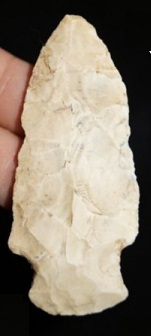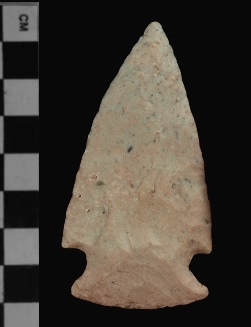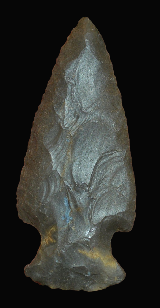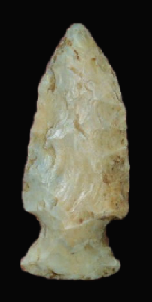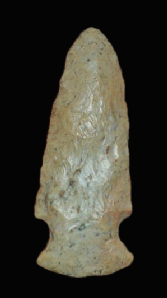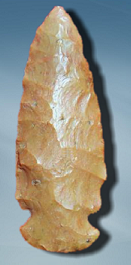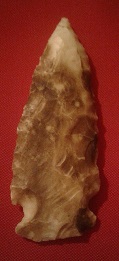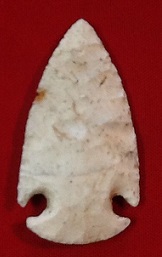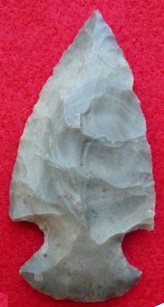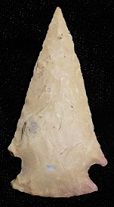Outline is Representative of Size and Shape:

Name Details:
Identified By: Edward G. Scully
Named For: Type Site
Date Identified: 1951
Type Site: Klunk-Gibson Mounds #4, Calhoun County, Illinois
Identified By: Edward G. Scully
Named For: Type Site
Date Identified: 1951
Type Site: Klunk-Gibson Mounds #4, Calhoun County, Illinois
Point Validity:
Valid type
Scully is a highly respected anthropologist from the University of Michigan who conducted extensive research in the Mississippi River valley and identified many different types of projectile points. This type was named in a professional publication and has many professional references. This is considered a valid type.
Scully is a highly respected anthropologist from the University of Michigan who conducted extensive research in the Mississippi River valley and identified many different types of projectile points. This type was named in a professional publication and has many professional references. This is considered a valid type.
Gibson Notched
Cluster: Snyders Cluster Description of Physical Characteristics and Flaking Pattern:
This is a triangular medium to large low side to corner notch point. This point primarily has a flattened cross section, but may have an elliptical in some of the thicker examples. The blade is most commonly excurvate, but some examples have a straight blade. The widest portion of the point is just above the shoulders with the tangs of the base usually being as wide as the shoulders. Deep round notches enter the corners of the preform forming a shoulders may range from slightly barbed to sloping upwards. The stem is wide and expanding with a convex base and lacks basal grinding. This point is manufactured using random percussion flaking with marginal pressure flaking forming a random flaking.
Size Measurements:
Total Length - 40 to 100 mm, Stem Length - 10 to 16 mm, Blade Width - 23 to 45 mm, Neck Width - 16 to 24 mm, Stem Width - 20 to 30 mm
Total Length - 40 to 100 mm, Stem Length - 10 to 16 mm, Blade Width - 23 to 45 mm, Neck Width - 16 to 24 mm, Stem Width - 20 to 30 mm
Commonly Utilized Material:
Various local heat treated materials and occasionally exotic materials such as Croton Tabular chert.
Various local heat treated materials and occasionally exotic materials such as Croton Tabular chert.
Additional Comments:
These points may have served many different purposes from knives to scrappers or points to ceremonial objects. The Snyders point has many different variations that served different purposes or covered different time spans. It is felt that the Hopewell and Snyders points may have been used in ceremonial purposes while the Affis Snyders point and the Manker point were more of the daily use points. (W2).
Others feel that the variations of points (Affis Snyders and Manker) may have been used by other cultures and not be true variations of the point (W11).
This type may be easily confused with the St. Charles Dovetail on examples with a pronounced convex base.
These points may have served many different purposes from knives to scrappers or points to ceremonial objects. The Snyders point has many different variations that served different purposes or covered different time spans. It is felt that the Hopewell and Snyders points may have been used in ceremonial purposes while the Affis Snyders point and the Manker point were more of the daily use points. (W2).
Others feel that the variations of points (Affis Snyders and Manker) may have been used by other cultures and not be true variations of the point (W11).
This type may be easily confused with the St. Charles Dovetail on examples with a pronounced convex base.
Distribution: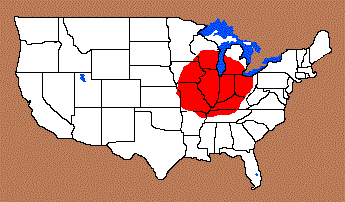
Distribution Comments:
This point is most commonly associated with Missouri , Illinois, and the Mid-Mississippi River Valley and into the the Ohio River Valley. This point is found into the Tennessee River Valley with decreased frequency.
This point is most commonly associated with Missouri , Illinois, and the Mid-Mississippi River Valley and into the the Ohio River Valley. This point is found into the Tennessee River Valley with decreased frequency.
Age / Periods:
Date: 2,000 - 1,500 B.P.
Cultural Period: Woodland
Glacial Period: Roman Warm
Culture: Hopewell Culture
Date: 2,000 - 1,500 B.P.
Cultural Period: Woodland
Glacial Period: Roman Warm
Culture: Hopewell Culture
Age Details:
Morrow (2016) notes that in "Illinois, these points are associated with the Middle Woodland Havana tradition and date to circa 200 B.C.E. to 200 C.E."
Morrow (2016) notes that in "Illinois, these points are associated with the Middle Woodland Havana tradition and date to circa 200 B.C.E. to 200 C.E."
Similar Points:
Amos, Becker, Big Creek, Burnt Bluff, Cupp, Dayton, Epps, Helton, Kings, Kirk Corner Notch, Lafayette, Motley, St Charles Dovetail, Stilwell, Thebes, Warrick
Amos, Becker, Big Creek, Burnt Bluff, Cupp, Dayton, Epps, Helton, Kings, Kirk Corner Notch, Lafayette, Motley, St Charles Dovetail, Stilwell, Thebes, Warrick
Other points in this cluster / Related / Associated Points:
Afffis Snyders, Grand, Hopewell, Mackinaw, Manker, Norton, North Blade, Snyders
Afffis Snyders, Grand, Hopewell, Mackinaw, Manker, Norton, North Blade, Snyders


